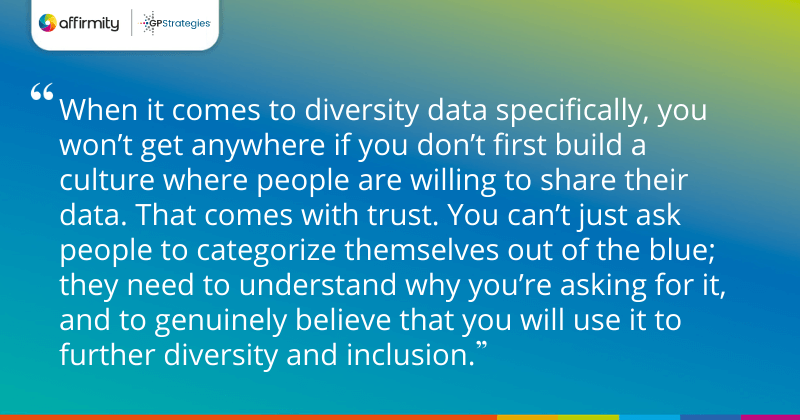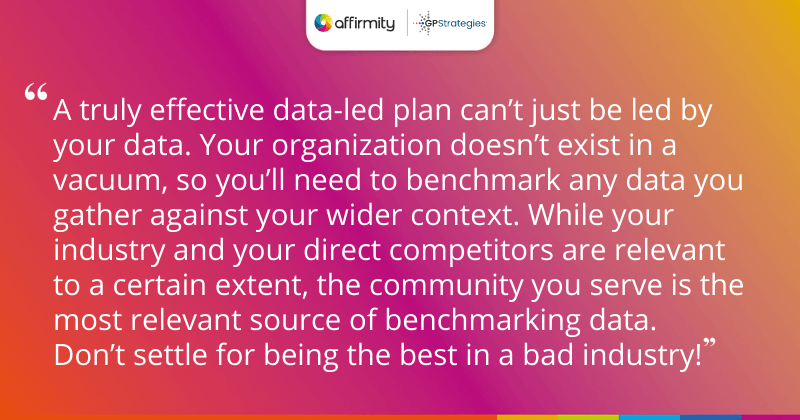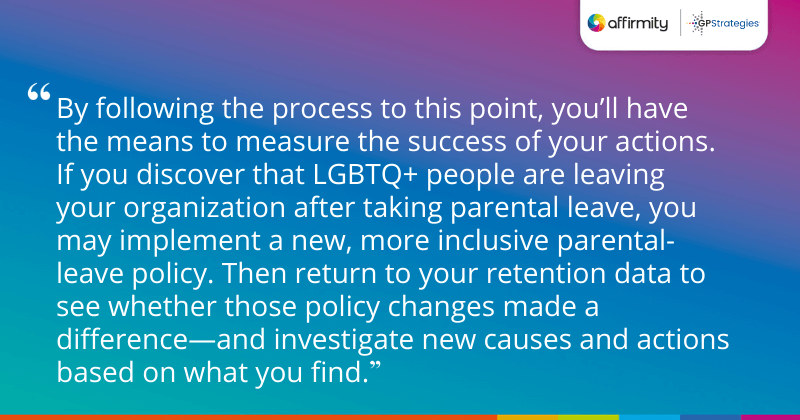While plenty of businesses agree that diversity, equity, and inclusion (DE&I) are key contributors to sustained success, many wish they were making more progress than they are. In this article, Eleanor Goichman Brett, trainer, and consultant at GP Strategies (an Affirmity inclusion training partner), looks at why a data-driven approach is essential.
DE&I gets treated very differently from typical business issues. There is a misconception that it isn’t possible or useful to measure DE&I-related activity or subjects. However, the proper way to approach DE&I is by using a data-driven strategy that creates outcomes both specific and measurable. Here are five steps your organization should take to realize such a strategy.

Step 1: Collect Diversity Data (But Lay the Groundwork First!)
You’ll have to forgive us for stating the obvious when we say that a data-driven plan starts with you collecting data. But what does that actually involve? When it comes to diversity data specifically, you won’t get anywhere if you don’t first build a culture where people are willing to share their data. That comes with trust. You can’t just ask people to categorize themselves out of the blue; they need to understand why you’re asking for it, and to genuinely believe that you will use it to further diversity and inclusion.
Clearly, to create this culture will take continuous effort and communication—it’s an important and necessary journey.
When you’re able to, you’ll also need to collect the right data. Go too narrow—recording just gender and ethnicity, for example—and you’ll give yourself an incomplete picture. Your people may even doubt your commitment. A good guiding principle is to collect data that helps you understand whether your workforce properly reflects the communities that you serve.
YOU MAY ALSO FIND INTERESTING | ‘An Introduction to the 4 Key Strategies Every DE&I Program Needs’
Step 2: Don’t Neglect Inclusion Data
Inclusion data is just as important as diversity data, though more likely to be overlooked. When collected correctly, it should tell you whether people really feel they belong, whether they’re understood, and whether they feel listened to. Inclusion-related questions can also be asked about important aspects of your organizational practices, such as your communications and your learning programs.
However, it’s important that you’re able to relate this data back to the groups in your diversity data. Organization-wide inclusion data can sound impressive but ultimately distract you from genuine issues. If 90% of people are telling you that your communications are inclusive, but that other 10% represent 100% of your disabled employees, the concerns of the latter group are what you should be most concerned about.

Step 3: Find Appropriate Benchmarks
A truly effective data-led plan can’t just be led by your data. Your organization doesn’t exist in a vacuum, so you’ll need to benchmark any data you gather against your wider context. While your industry and your direct competitors are relevant to a certain extent, the community you serve is the most relevant source of benchmarking data. Measuring yourself against an industry that simply isn’t making an effort to serve the diversity of the wider community can only really make you complacent. Don’t settle for being the best in a bad industry!
FURTHER THOUGHTS ON BENCHMARKING | ‘Your Diversity Metrics: How to Break Down Employee Data and Benchmark Representation’
Step 4: Discover What’s Driving the Data
By cross-referencing your diversity data with your people data, you can begin to understand what’s driving that diversity data. How does it interact with recruitment, promotions, attrition, and absences? Answering that question will better lead you toward creating a meaningful and targeted action plan and reveal where you have significant barriers to diversity.
For example, this process can help you understand if you have a problem with assessing or promoting talent in certain groups, or if you’re failing in your attempts to attract and appeal to particular diverse communities.
On the flip side, it can also help you identify where expensive solutions may not be necessary. A good example of this is anonymizing recruitment processes—a labor-intensive activity that many organizations have moved toward regardless of whether any bias was actually found in the process. After all, the issue may actually be that you’re not getting a diversity of applicants—meaning your money could be better spent elsewhere.

Step 5: Continue to Measure Ongoing Activity
By following the process to this point, you’ll have the means to measure the success of your actions going forward. If you discover that LGBTQ+ people are leaving your organization after taking parental leave, you may implement a new, more inclusive parental-leave policy. At that point, you can return to your retention data to see whether those policy changes made a difference—and investigate new causes and actions based on what you find.
MORE ON THE IMPORTANCE OF INCLUSION | ‘Why Safeguarding Inclusion Is the Key to Riding Out the Great Resignation’
In Conclusion—Why Data-Led DE&I Is So Powerful
Because they allow for strategic and measurable actions, data-driven DE&I plans are more likely to produce results. They can also help you prove the existence of certain issues when people in the organization are unable or unwilling to recognize that a problem exists. When faced with evidence, numbers, and facts that clearly demonstrate that injustice operates unchecked, it cannot be as easily denied. Only then can we begin to work together towards a solution.
To learn more about the processes and systems that will help you make sense of your diversity and inclusion metrics, contact us today.
A version of this article previously appeared in Diversity Journal Magazine (First Quarter 2022).
 About the Author
About the Author
Eleanor Goichman Brett is a Global Inclusion Consultant at GP Strategies. Having completed a dissertation in the unconscious bias of attractiveness, she has also worked at Virgin Media, the Alzheimer’s Society and Ciklum Software to implement internal diversity and inclusion and accessibility strategies. With a motto of ‘data, action, data’, Eleanor helps organizations not only design and implement inclusion and learning plans that are right for them but also ensure measurement and sustainability.
